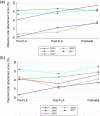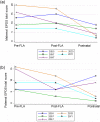Parental attachment and depressive symptoms in pregnancies complicated by twin-twin transfusion syndrome: a cohort study
- PMID: 31892359
- PMCID: PMC6938629
- DOI: 10.1186/s12884-019-2679-7
Parental attachment and depressive symptoms in pregnancies complicated by twin-twin transfusion syndrome: a cohort study
Abstract
Background: Twin-twin transfusion syndrome (TTTS) is a highly morbid condition in which treatment exists, but the pregnancy remains high-risk until delivery. It may have serious sequelae, including fetal death, and in the longer term, neurodevelopmental problems. The aim of this study is to assess antenatal and postnatal parental attachment and depressive symptoms in those with pregnancies affected by TTTS.
Methods: Couples attending for fetoscopic laser ablation treatment of TTTS were asked to complete Condon's Maternal/Paternal Antenatal/Postnatal Attachment Scale as appropriate, and the Edinburgh Depression Scale the day before ablation, 4 weeks post-ablation, and 6-10 weeks postnatally.
Results: 25/27 couples completed the pre-ablation questionnaire (median gestational age 19 + 3 weeks [interquartile range 18 + 2-20 + 6]). 8/18 eligible couples returned the post-ablation questionnaire. 5/17 eligible couples returned the postnatal questionnaire. There was no significant difference in parento-fetal attachment when mothers were compared to fathers at each time point, however parento-fetal attachment did increase over time in mothers (p = 0.004), but not fathers. Mothers reported more depressive symptoms antenatally compared to fathers (p < 0.02), but there was no difference postnatally. 50% women reported Edinburgh Depression Scale scores above the cut-off (≥15) 4 weeks post-ablation. Over time maternal depressive symptoms decreased (p = 0.006), however paternal depressive symptoms remained the same.
Conclusions: This is the first attachment and depression study in a UK cohort of parents with pregnancies affected by TTTS. Although this was a small cohort and the questionnaires used had not been validated in these circumstances, the results suggest that centres caring for these couples should be aware of the risk of maternal and paternal antenatal depression, and screen and refer for additional psychological support. Further work is needed in larger cohorts.
Trial registration: ISRCTN 13114861 (retrospectively registered).
Keywords: Attachment; Depression; Maternal; Paternal; TTTS; Twin pregnancy.
Conflict of interest statement
The authors declare that they have no competing interests.
Figures


Comment in
-
Letter to the Editor in response to 'Parental attachment and depressive symptoms in pregnancies complicated by twin-twin transfusion syndrome: a cohort study'.BMC Pregnancy Childbirth. 2021 Mar 22;21(1):242. doi: 10.1186/s12884-021-03688-7. BMC Pregnancy Childbirth. 2021. PMID: 33752620 Free PMC article.
Similar articles
-
Impact of Monochorionicity and Twin to Twin Transfusion Syndrome on Prenatal Attachment, Post Traumatic Stress Disorder, Anxiety and Depressive Symptoms.PLoS One. 2016 Jan 11;11(1):e0145649. doi: 10.1371/journal.pone.0145649. eCollection 2016. PLoS One. 2016. PMID: 26751570 Free PMC article.
-
Subsequent fertility, pregnancy, and gynecologic outcomes after fetoscopic laser therapy for twin-twin transfusion syndrome compared with normal monochorionic twin gestations.Am J Obstet Gynecol. 2018 Apr;218(4):447.e1-447.e7. doi: 10.1016/j.ajog.2018.01.013. Epub 2018 Jan 12. Am J Obstet Gynecol. 2018. PMID: 29338992
-
Twin-twin transfusion syndrome: a frequently missed diagnosis with important consequences.Ultrasound Obstet Gynecol. 2014 Aug;44(2):205-9. doi: 10.1002/uog.13328. Epub 2014 Jun 27. Ultrasound Obstet Gynecol. 2014. PMID: 24549628
-
Twin-twin transfusion syndrome in the era of fetoscopic laser surgery: antenatal management, neonatal outcome and beyond.Expert Rev Hematol. 2020 Mar;13(3):259-267. doi: 10.1080/17474086.2020.1720643. Epub 2020 Jan 31. Expert Rev Hematol. 2020. PMID: 31971028 Review.
-
Isolated Ascites in a Monochorionic Twin after Fetoscopic Laser Ablation Is Not Necessarily Secondary to Recurrence or Anaemia: Bowel Complications in Twin-to-Twin Transfusion Syndrome after Fetoscopic Laser Ablation.Fetal Diagn Ther. 2019;45(5):285-294. doi: 10.1159/000494616. Epub 2018 Dec 14. Fetal Diagn Ther. 2019. PMID: 30554214
Cited by
-
Letter to the Editor in response to 'Parental attachment and depressive symptoms in pregnancies complicated by twin-twin transfusion syndrome: a cohort study'.BMC Pregnancy Childbirth. 2021 Mar 22;21(1):242. doi: 10.1186/s12884-021-03688-7. BMC Pregnancy Childbirth. 2021. PMID: 33752620 Free PMC article.
-
Authors' reply to: Letter to the Editor in response to 'Parental attachment and depressive symptoms in pregnancies complicated by twin-twin transfusion syndrome: a cohort study'.BMC Pregnancy Childbirth. 2021 Mar 22;21(1):241. doi: 10.1186/s12884-021-03687-8. BMC Pregnancy Childbirth. 2021. PMID: 33752627 Free PMC article.
-
'We did everything we could'- a qualitative study exploring the acceptability of maternal-fetal surgery for spina bifida to parents.Prenat Diagn. 2021 Jul;41(8):910-921. doi: 10.1002/pd.5996. Epub 2021 Jul 18. Prenat Diagn. 2021. PMID: 34228835 Free PMC article.
References
-
- Beauquier-Maccotta B, Chalouhi G, Picquet A, Carrier A, Bussieres L, Golse B, et al. Impact of monochorionicity and twin to twin transfusion syndrome on prenatal attachment, post traumatic stress disorder, anxiety and depressive symptoms. PLoS One. 2016;11(1):e014564. doi: 10.1371/journal.pone.0145649. - DOI - PMC - PubMed
-
- Berghella V, Kaufmann M. Natural history of twin-twin transfusion syndrome. J Reprod Med. 2001;46(5):480–484. - PubMed
MeSH terms
Grants and funding
LinkOut - more resources
Full Text Sources
Medical

